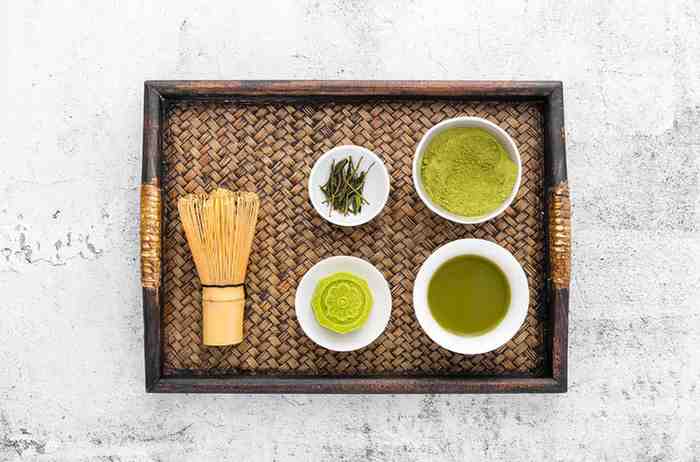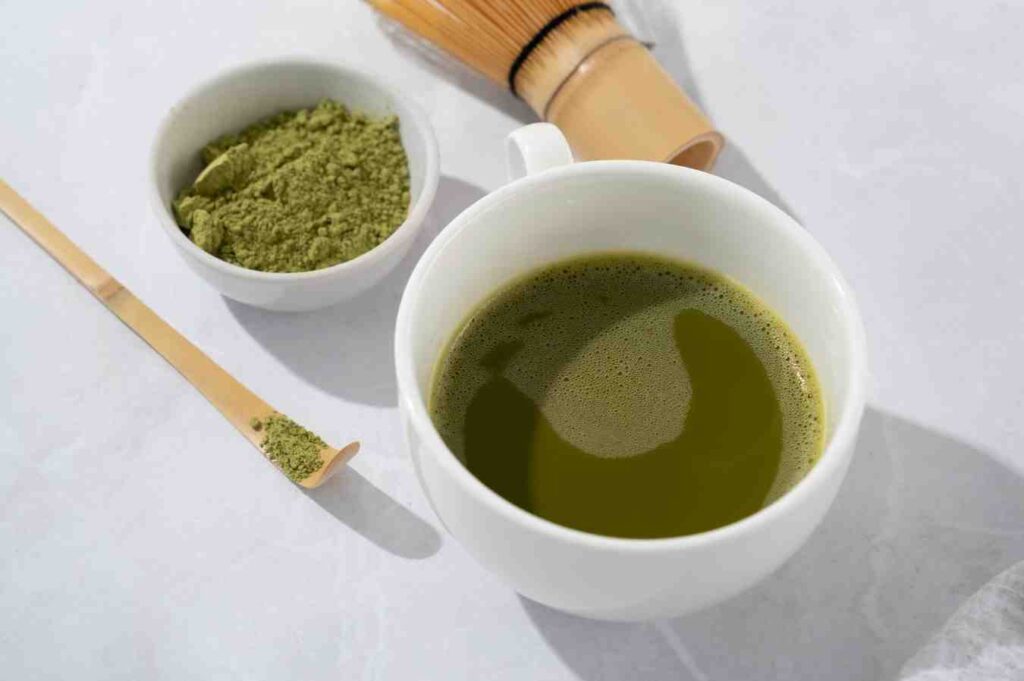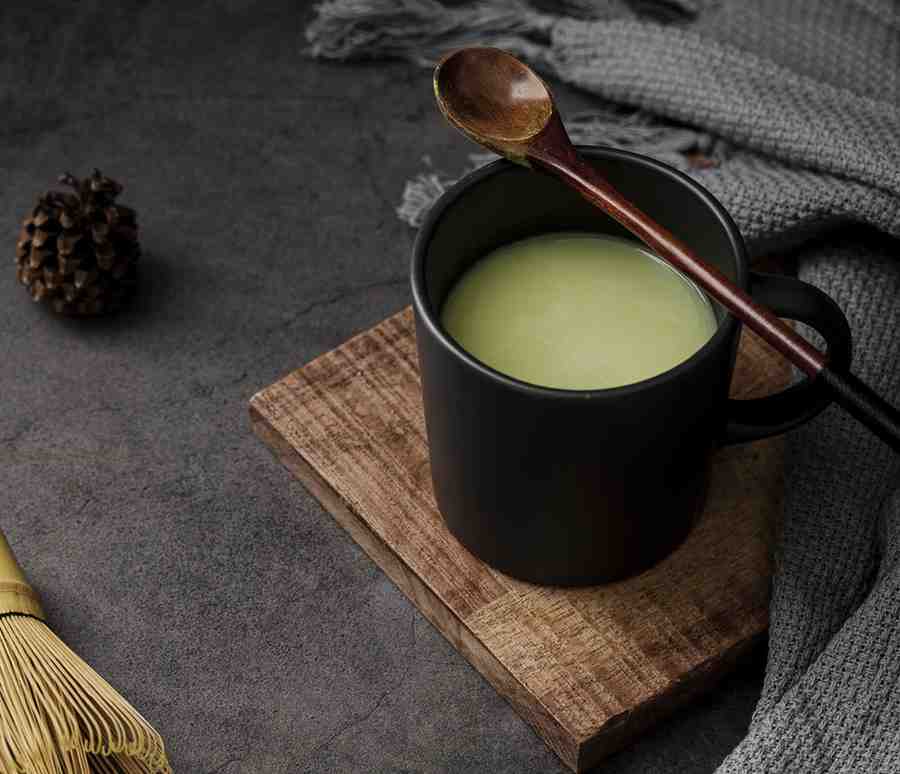Matcha tea, a vibrant green powder, originates from Japan and has gained global popularity for its rich flavor and numerous health benefits. Unlike traditional green tea, matcha uses entire tea leaves ground into a fine powder, offering a more concentrated source of antioxidants and nutrients. Today, matcha is enjoyed in a variety of ways, from traditional tea ceremonies to modern lattes and smoothies.
- Unique Preparation: Matcha is whisked into hot water, creating a frothy, rich drink with a creamy texture.
- High Antioxidant Content: Contains more antioxidants than regular green tea, making it a superfood for health enthusiasts.
- Versatile Use: Beyond tea, matcha can be used in desserts, smoothies, and even savory dishes.
What is Matcha Tea?
Matcha tea stands out due to its special production process, which results in a higher concentration of beneficial compounds. Understanding how matcha is grown and produced sheds light on why it’s different from other green teas.
Understanding Matcha Tea Production
Matcha is made from the leaves of the Camellia sinensis plant, the same plant used for green tea. However, the way these leaves are grown and processed sets matcha apart.
- Shade-Grown Process: Farmers shade matcha plants for about three to four weeks before harvest. This process boosts chlorophyll levels, resulting in a vibrant green color and increased amino acids like L-theanine.
- Harvesting and Grinding: After harvesting, workers remove the stems and veins from the leaves. The leaves are then stone-ground into a fine powder, creating matcha. This method preserves the full nutrient profile of the leaves.
- Types of Matcha: There are two primary grades of matcha—ceremonial and culinary. Ceremonial-grade matcha is the highest quality, used in traditional tea ceremonies. Culinary-grade matcha, with a slightly stronger taste, is ideal for cooking and baking.
Matcha’s unique production method means you consume the entire leaf, not just an infusion. This difference gives matcha a richer flavor and a higher concentration of nutrients than regular green tea.
The History of Matcha Tea
The history of matcha tea dates back over a thousand years, with deep roots in Japanese culture and Zen Buddhism. Its journey from ancient rituals to modern-day cafes tells a story of tradition and adaptation.
- Origins in Japan: Matcha first appeared in Japan during the 12th century when Buddhist monks brought the tea leaves from China. They used it during meditation sessions to maintain focus and calm.
- Zen Buddhism and Tea Ceremonies: In the 16th century, matcha became central to Japanese tea ceremonies, known as “chanoyu.” These rituals focus on the beauty of simplicity, mindfulness, and the appreciation of the present moment.
- Global Spread: In recent decades, matcha has gained popularity outside of Japan, especially in Western countries. Health enthusiasts appreciate its powerful antioxidants, while chefs use it to add flavor and color to various dishes.
Today, matcha remains a symbol of both tradition and wellness, bridging the ancient world with modern health trends.
What is Matcha Tea Good For?
Matcha tea offers a wide range of health benefits, making it more than just a flavorful drink. Its high concentration of nutrients supports both physical and mental well-being.
Key Health Benefits of Matcha
Matcha is rich in catechins, a type of antioxidant that helps combat oxidative stress and reduce inflammation. It provides several health benefits that make it a popular choice for those looking to boost their wellness.
- Packed with Antioxidants: Matcha contains high levels of EGCG (epigallocatechin gallate), a potent antioxidant that helps protect cells from damage. This can lower the risk of chronic diseases like cancer.
- Supports Heart Health: Drinking matcha regularly may improve heart health by reducing bad cholesterol (LDL) levels. Studies suggest that matcha can also help regulate blood pressure.
- Boosts Metabolism: Matcha’s combination of caffeine and catechins can help boost metabolism, making it easier for the body to burn fat. This makes matcha a popular addition to weight management plans.
- Natural Detoxifier: The high chlorophyll content in matcha aids in detoxifying the body by helping to remove heavy metals and toxins. This makes matcha a great choice for those looking to support liver health.
These benefits make matcha a versatile addition to a balanced diet, offering both immediate and long-term health advantages.
Cognitive and Mental Health Benefits
Matcha tea is known for its ability to improve focus and provide a balanced energy boost without the jitters often associated with coffee. This makes it ideal for enhancing productivity and supporting mental clarity.
- Focus and Alertness: The L-theanine in matcha works with caffeine to create a state of calm alertness. This allows for sustained concentration, making it perfect for work or study sessions.
- Stress Reduction: L-theanine also promotes relaxation by increasing alpha waves in the brain. These waves are associated with a state of relaxed yet alert mind, similar to the feeling after meditation.
- Enhances Memory: Some studies suggest that the combination of caffeine and L-theanine in matcha may improve cognitive functions such as memory and attention.
Matcha’s ability to support mental well-being makes it a popular choice for those looking to enhance both mind and body.

Is It Safe to Drink Matcha Tea Daily?
Drinking matcha daily can provide numerous benefits, but it’s important to do so in moderation. Understanding the optimal amount helps maximize the benefits while avoiding any potential downsides.
Daily Consumption Recommendations
Matcha is a concentrated source of nutrients, so even small amounts can have a powerful effect. For most people, 1–2 cups of matcha per day is ideal.
- Ideal Serving Size: Use about 1 teaspoon (2 grams) of matcha powder per cup. This provides a good balance of caffeine and antioxidants without overloading your system.
- Benefits of Daily Use: Drinking matcha every day can help maintain consistent energy levels, improve focus, and support overall wellness.
- Possible Side Effects: While matcha is generally safe, consuming too much can lead to insomnia or digestive issues due to its caffeine content. It’s best to enjoy matcha earlier in the day to avoid sleep disturbances.
Moderation allows you to enjoy the full range of benefits matcha offers, making it a valuable part of a healthy lifestyle.
Balancing Benefits and Risks
While matcha is rich in health benefits, it’s important to be mindful of certain factors to ensure safe consumption.
- Caffeine Content: Matcha contains more caffeine than regular green tea, so it’s essential to adjust your intake if you’re sensitive to caffeine. Pairing matcha with food can help reduce its impact on the stomach.
- Choosing Organic Matcha: Opting for organic matcha helps minimize exposure to pesticides and other chemicals that may be present in non-organic varieties.
- Combining with a Balanced Diet: Matcha works best when combined with a balanced diet rich in whole foods. It can complement other sources of antioxidants, providing comprehensive support for your health.
By following these guidelines, you can safely enjoy matcha as a daily part of your wellness routine.
What Does Matcha Taste Like?
Matcha’s flavor is distinct and can take some getting used to. Its taste varies based on the quality of the matcha and how it’s prepared.
Tasting Notes of Matcha
Matcha has a rich, umami flavor that sets it apart from other teas. It is often described as vegetal, earthy, and slightly sweet.
- Umami and Grassiness: The shade-grown process gives matcha its deep green color and umami taste, with hints of fresh grass and seaweed.
- Sweetness and Creaminess: High-quality ceremonial matcha has a naturally smooth and creamy texture, with a subtle sweetness that balances the earthy notes.
- Adjusting the Flavor: If matcha tastes too bitter, try using cooler water or adding a natural sweetener like honey. Blending matcha into lattes with milk can also soften the flavor.
Understanding matcha’s flavor profile helps you appreciate its complexity and find ways to enjoy it that suit your palate.
Is Matcha Tea Healthier Than Green Tea?
Many people wonder if matcha tea offers more health benefits than traditional green tea. While both come from the same plant, their differences in processing and consumption make matcha a more concentrated source of nutrients.
Nutritional Comparison with Green Tea
Matcha contains higher levels of antioxidants and beneficial compounds compared to regular green tea. This is because matcha uses the entire tea leaf, providing a richer nutrient profile.
- Higher Antioxidant Levels: Matcha is packed with antioxidants like EGCG (epigallocatechin gallate), which help protect the body from free radicals. Drinking matcha can offer more potent antioxidant effects than a standard cup of green tea.
- More Caffeine and L-Theanine: Matcha has more caffeine due to the concentrated nature of its powder form. It also contains higher levels of L-theanine, an amino acid that promotes calm focus, making it ideal for those seeking a balanced energy boost.
- Rich in Chlorophyll: The shade-growing process used for matcha increases its chlorophyll content. This compound helps detoxify the body, supporting liver function and promoting healthy skin.
Matcha’s concentrated nature allows for a richer taste and a more significant impact on health compared to regular green tea, making it a preferred choice for those looking for a stronger boost.
When to Choose Matcha Over Green Tea
Although both matcha and green tea offer health benefits, matcha may be better suited for specific needs and occasions.
- Energy Boost: Matcha’s higher caffeine content makes it a great choice for mornings or as a pre-workout drink. It provides sustained energy without the jitters often associated with coffee.
- Focus and Relaxation: The combination of caffeine and L-theanine in matcha promotes a state of relaxed alertness. This makes it an excellent option for studying, working, or meditating.
- Green Tea for Milder Taste: Traditional green tea may be a better choice for those who prefer a milder flavor or want a lighter caffeine kick. It’s a gentle way to enjoy the benefits of tea without the intensity of matcha.
Understanding the differences between matcha and green tea helps you decide which one fits your lifestyle and preferences.

How to Prepare and Enjoy Matcha Tea
Preparing matcha is both an art and a science. The traditional method involves using specific tools to create a smooth, frothy drink, but modern variations offer plenty of creative ways to enjoy matcha.
Traditional Method: Whisking with a Bamboo Whisk
To fully appreciate matcha’s rich flavor and creamy texture, follow the traditional preparation method using a bamboo whisk, or chasen.
- Step-by-Step Guide:
- Sift 1–2 teaspoons of matcha powder into a bowl to remove any clumps.
- Add about 2 ounces of hot water (not boiling, ideally 160–175°F or 70–80°C).
- Use a bamboo whisk to whisk the matcha in a zigzag motion until it becomes frothy.
- Tips for a Perfect Cup:
- Use a ceramic bowl (chawan) to retain heat and appreciate the vibrant green color.
- Whisking vigorously creates a creamy texture and smooth finish.
- Adjust the amount of matcha or water to taste, creating a thicker “koicha” or lighter “usucha” matcha.
This traditional method allows you to savor matcha as it has been enjoyed in Japan for centuries, emphasizing mindfulness and appreciation of the tea’s qualities.
Creative Matcha Recipes
Matcha’s versatility extends beyond traditional tea. You can use it in various recipes to enjoy its flavor in new and exciting ways.
- Matcha Lattes: Blend matcha with steamed milk for a creamy matcha latte. Add a touch of honey or vanilla syrup for sweetness. Iced matcha lattes are perfect for warm days.
- Smoothies: Add a teaspoon of matcha to your morning smoothie for an antioxidant boost. It pairs well with fruits like banana, mango, and spinach.
- Baking with Matcha: Use matcha powder in cookies, cakes, and muffins to add a unique green hue and a hint of earthy flavor. Matcha can elevate desserts like matcha brownies or cheesecake.
These recipes allow you to incorporate matcha into your diet in fun and delicious ways, making it easy to enjoy its benefits throughout the day.
FAQs About Matcha Tea
Matcha tea is a subject of curiosity for many. Here are some common questions and concise answers to help you understand matcha better.
What is Matcha Tea Good For?
Matcha tea is beneficial for boosting energy, improving focus, and supporting overall health. Its high levels of antioxidants can help combat free radicals, potentially reducing the risk of chronic diseases. Matcha also aids in weight management by boosting metabolism and promoting fat oxidation.
Is it OK to Drink Matcha Tea Every Day?
Yes, it is safe to drink matcha daily, as long as it is consumed in moderation. Most experts recommend 1–2 cups per day, which provides enough antioxidants and caffeine without risking side effects like insomnia or digestive issues. For those sensitive to caffeine, it’s best to drink matcha earlier in the day.
Is Matcha Tea Healthier than Green Tea?
Matcha is generally considered healthier than regular green tea due to its concentrated nutrient profile. It contains higher levels of antioxidants, chlorophyll, and L-theanine, offering stronger health benefits. However, both matcha and green tea can be valuable parts of a balanced diet.
What Does Matcha Taste Like?
Matcha has a rich, earthy flavor with notes of umami, which makes it taste savory and slightly vegetal. High-quality matcha can have a naturally sweet finish, while lower grades may taste more bitter. Pairing matcha with sweeteners or milk can balance its earthy notes, creating a smoother, more approachable taste.
The Rise of Matcha in Modern Health Trends
Matcha’s rise in popularity goes beyond its traditional roots. Today, it plays a significant role in the global wellness movement, with its benefits and vibrant green color making it a favorite among health-conscious consumers.
Matcha in Western Wellness Culture
Matcha has become a staple in cafes and health stores across Europe, North America, and beyond. It is often featured in lattes, smoothies, and even as an ingredient in protein shakes.
- Social Media Influence: Platforms like Instagram and TikTok have helped popularize matcha with videos showcasing matcha art and innovative matcha recipes.
- Functional Foods: As part of the trend towards functional beverages, matcha is often marketed as a superfood. Its high levels of antioxidants and energy-boosting properties attract those looking to improve their diet naturally.
- Appeal to Millennials and Gen Z: Matcha’s vibrant green color and versatility in recipes make it a favorite among younger generations who value health and creativity.
This new popularity has allowed matcha to reach a broader audience, blending ancient traditions with modern health trends.
Choosing the Best Matcha for Your Needs
With many types of matcha on the market, choosing the right one can make a big difference in taste and benefits. Understanding the differences between grades helps you make an informed choice.
- Ceremonial vs. Culinary Grade: Ceremonial-grade matcha is smoother and more delicate, making it ideal for drinking on its own. Culinary-grade matcha has a stronger flavor, perfect for cooking, baking, and mixing into drinks.
- Look for Bright Green Color: High-quality matcha should be vibrant green, indicating freshness and high chlorophyll content. Avoid matcha with a dull or yellowish hue.
- Check the Origin: Matcha grown in Japan, particularly from regions like Uji and Nishio, is known for its superior quality. Choosing matcha from these regions ensures an authentic experience.
- Store Properly: Keep matcha in an airtight container, away from light and moisture, to preserve its flavor and freshness.
By selecting the right matcha, you can enjoy its full range of flavors and health benefits.

